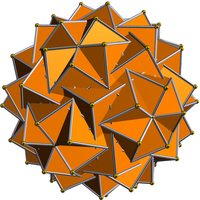Great hexagonal hexecontahedron
Jump to navigation
Jump to search
| Great hexagonal hexecontahedron | |
|---|---|
 | |
| Rank | 3 |
| Type | Uniform dual |
| Notation | |
| Coxeter diagram | p5/3p5/2p3*a |
| Elements | |
| Faces | 60 irregular hexagons |
| Edges | 60+60+60 |
| Vertices | 20+24+60 |
| Vertex figure | 20+60 triangles, 24 pentagrams |
| Measures (edge length 1) | |
| Inradius | |
| Dihedral angle | 90° |
| Central density | 10 |
| Number of external pieces | 240 |
| Related polytopes | |
| Dual | Great snub dodecicosidodecahedron |
| Conjugate | Great hexagonal hexecontahedron |
| Convex core | Non-Catalan deltoidal hexecontahedron |
| Abstract & topological properties | |
| Flag count | 720 |
| Euler characteristic | –16 |
| Orientable | Yes |
| Properties | |
| Symmetry | H3+, order 60 |
| Convex | No |
| Nature | Tame |
The great hexagonal hexecontahedron is a uniform dual polyhedron. It consists of 60 irregular hexagons, each with two short, two medium, and two long edges.
If its dual, the great snub dodecicosidodecahedron, has an edge length of 1, then the hexagon faces have short edge length , medium edge length , and long edge length . The hexagons have one interior angle of , one of , and four of 90°, where is the golden ratio.
The great hexagonal hexecontahedron and the cube are the only finite non-degenerate isohedral polyhedra with right dihedral angles.
Vertex coordinates[edit | edit source]
A great hexagonal hexecontahedron with dual edge length 1 has vertex coordinates given by all even permutations of:
as well as all even permutations and even sign changes of:
External links[edit | edit source]
- Wikipedia contributors. "Great hexagonal hexecontahedron".
- McCooey, David. "Great Hexagonal Hexecontahedron"














